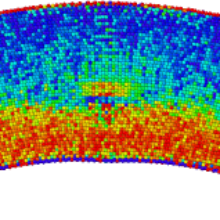Dr. Prashanth Srinivasan has been a Humboldt Research Fellow at the University of Stuttgart since March this year. The postdoc carries out research as part of the team led by Prof. Blazej Grabowski in the Department of Materials Design at the Institute for Materials Science. Prashanth Srinivasan was born in India. He finished his bachelor’s and master’s degree studies in Chennai before completing his doctorate at the Delft University of Technology in the Netherlands.
It was a start to remember for Prashanth Srinivasan when he first arrived at the University of Stuttgart in October 2020, originally as a postdoc as part of a project run by the European Research Council (ERC). His friends who helped him with the move had to go back home straight away afterwards because of the pandemic, and couldn’t stay overnight. The accommodation building at the Campus Vaihingen was empty. “It was a bit lonely to start off”, says Prashanth Srinivasan, though he liked the campus straight away. Since then he has moved to Kaltental, where he has made friends, and he will also soon be able to hold a conversation in German, since he is currently attending an intensive language course in Frankfurt.
Novel alloys with memory
He will be able to spend two years at the University of Stuttgart dedicating himself to his research. With the help of computer-assisted technology, Prashanth Srinivasan will investigate materials down to the atomic level in order to design new kinds of alloys with memory. These kind of shape-memory alloys (SMAs) change shape depending on temperature and stress. Prof. Grabowski’s department offers him the ideal conditions to carry out his work. There the team uses the latest calculation methods, which also incorporate molecular dynamics, and combines them with machine learning methods to model materials with high precision at high speed.
Prashanth Srinivasan first became aware of Stuttgart thanks to one of his research colleagues in Delft. When he was working together with Dr. Fritz Körmann after his doctoral degree studies in “Atomistic Simulations of Nickel-Titanium SMAs”, Dr. Körmann told him about Professor Grabowski and his team at the University of Stuttgart and encouraged him to apply for a Humboldt scholarship. “I knew Germany already”, says Prashanth Srinivasan. “In 2011 I spent three months in Bochum on a DAAD scholarship. That was when I realized how much I liked living and working here.”
New materials for medicine or robotics
Prashanth Srinivasan is investigating the thermodynamic properties of SMAs. In order to determine and model these properties, he uses mathematic calculations and incorporates methods of machine learning. In the process, he uses techniques used by the Department for Materials Design and develops them further. His aim is to create numerical predictions of the properties which alloys go through when a transformation process occurs at high temperatures. Based on these findings he hopes it will be possible to design new materials, the transformation of which can be “switched on” where necessary. “These kind of materials could be used for example in medicine or robotics”, explains Prashanth Srinivasan, who alongside his research also enjoys passing on his knowledge to students, such as by supervising master's theses.
Trips to the mountains
Prashanth Srinivasan likes going jogging in the evenings to help him relax. Squash and basketball – his favorite sports – are unfortunately off the table at the moment due to corona. But going on daytrips is still possible. The Black Forest and the mountains are a favorite destination of his, where the experience of high altitudes is particularly enjoyable to our guest from Holland.




